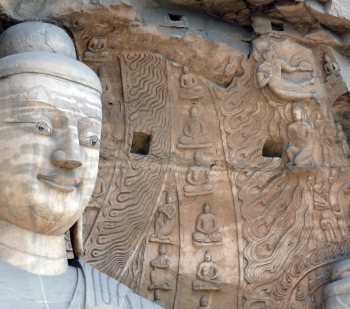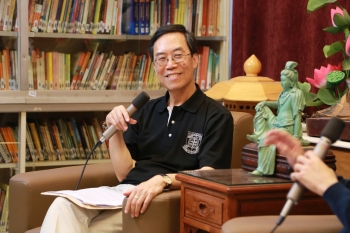Editor's note: “Teachings of Amitabha Buddha” is an inspiring column about the vital spiritual matters of Pure Land Buddhism – from its history, philosophy, and practice to its scriptures and their exegesis and interpretation. The column is penned by Alan Kwan, the founding editor of Buddhistdoor.com.
Master Shandao of the Tang Dynasty opened the Pure Land school in accordance with the teachings of two Buddhas, namely Shakyamuni Buddha and Amitabha Buddha. The former is known as the Path of Importance, and the latter is the Path of Great Vow. For the definitions of the two paths, please refer to my article, Following the teachings of two Buddhas, I open the door to the Pure Land.
Master Shandao of the Tang Dynasty opened the Pure Land school in accordance with the teachings of two Buddhas, namely Shakyamuni Buddha and Amitabha Buddha. The former is known as the Path of Importance, and the latter is the Path of Great Vow. For the definitions of the two paths, please refer to my article, Following the teachings of two Buddhas, I open the door to the Pure Land.
Both paths can lead us to rebirth in the Pure Land. Yet the two paths are two distinct and separate teachings, independent of each other. If one follows strictly the teaching of either path, one will certainly achieve rebirth in the Pure Land. However, you may ask, “Which one should I follow?” It depends on one’s own capacity, interest, virtuous roots, meritorious blessing and many other causal conditions. Some people may further ask, “Can we follow both?” Sure, some follow both. They are generally called Pure Land practitioners in ‘mixed practices.’
Response upon hearing the Path of Great Vow
The Path of Great Vow is simple and easy to practice, but difficult to believe. If one recites Amitabha’s name exclusively in one’s present life, or even near the end of one’s life, upon hearing the teaching of this Path, he or she will be certainly reborn in the realm of unconditioned nirvana without cutting off the karmic obstructions. Isn’t it incredible? Some people may not believe it, as they think that it is too good to be true.
As Shakyamuni Buddha said in the Amitabha Sutra, Shariputra, you must realize that I have accomplished this difficult task during the period of the five defilements. That is to say, having attained the highest, perfect Enlightenment, I have, for the sake of all in the world, delivered this teaching, which is so hard for them to accept. This is indeed an extremely difficult task. Pure Land Buddhism is well known to be a teaching that is really difficult for us to believe and accept, and it is even harder than Shakyamuni Buddha’s time to attain Enlightenment in our world with the Five Turbidities. Only very few practitioners with really strong and deep virtuous root in faith or wisdom would believe and follow the Path of Great Vow to be reborn in the Land of Bliss.
Upon hearing this splendid teaching of Amitabha Buddha, people may have three kinds of responses, which will result in three different scenarios:
1. Take the Path of Great Vow and discard the Path of Importance.
Master Shandao concluded his commentary on the Contemplation Sutra thus: “Though preceding passages spoke of the merits of the meditative and non-meditative virtues, the Buddha’s underlying wish is that sentient beings recite Amitabha’s name single-mindedly.” The key word is ‘single-mindedly’. It means exclusively, wholeheartedly, consistently and persistently. As Amitabha-recitation is the single one, there is no other practice for a pristine Pure Land practitioner.
Obviously, the practitioners deeply believe in Amitabha’s teaching in the Path of Great Vow, and they entrust themselves to Amitabha Buddha’s deliverance. They rely on the merits and virtues dedicated by Amitabha Buddha, which can be attained through Amitabha-recitation, thus they dedicate all their previous merits and virtues attained through the meditative and non-meditative practices to other sentient beings. They understand that their unreal and impure merits and virtues that they accumulate life after life are not in accord with what is needed to enter the realm of unconditioned nirvana.
Their rebirth in the Land of Bliss is assured in the present life under the 18th vow of Amitabha Buddha. Generally speaking, it is a minority in this scenario. Master Shandao says that this person is like a big white lotus, which is rare and special amongst all human beings.
2. Take the Path of Great Vow as main and primary practice and the Path of Importance as supplementary and secondary.
Master Shandao categorized the Buddha’s invocation into five aspects in his Commentary of the Contemplation Sutra,
(1) Exclusive reading – reading the three Pure Land Sutras only
(2) Exclusive observance – observing Amitabha Buddha and his Land of Bliss only
(3) Exclusive reverence – bowing to Amitabha Buddha only
(4) Exclusive recitation – reciting Amitabha Buddha’s name only
(5) Exclusive praising and making offerings – again to Amitabha Buddha only
Amongst these five exclusive practices, exclusive Amitabha-recitation is the ‘karma of assurance’ because it accords with the fundamental vow of Amitabha Buddha. The other four are called the ‘supplementary karma’ or ‘secondary karma’ because they play the role of ‘catalyst’ in the course of establishing and developing faith, as explained in the Commentary of the Contemplation Sutra, though they are also regarded as the exclusive practice. The practitioner’s rebirth is assured in the present life under the fundamental vow, the 18th vow of Amitabha Buddha.
However, if the practitioners read other sutras, observe other Buddhas and pure lands, pay reverence to other Buddhas, recite other Buddha’s names and praise and make offerings to other Buddhas, their practices are called ‘mixed practices.’ Master Shandao commented on this kind of practice, “Our thoughts are interrupted. Though we can be reborn in the Pure Land, through the dedication of merit, these are known as distant, mixed practices”.
It usually takes the practitioners some time to gradually build up their faith by reading the Pure Land sutras, thinking of the magnificent Amitabha Buddha and His Pure Land and aspiring to be reborn there, before they start to recite the Amitabha’s name exclusively and consistently. Some may take the assorted or mixed practices during the transition period from the Path of Importance to the Path of Great Vow.
3. Consider the two paths are equally important, complementary to each other and practice them in parallel.
This scenario is fully described in the passage of ‘three grades of aspirants’ in the Infinite Life Sutra. Combining the 18th vow and 19th vow; and the aspirants believe that there are two main causes of rebirth in the Pure Land: one is to set forth the Bodhi Mind to become Bodhisattvas, and the other is to recite Amitabha’s name in a consistent and persistent manner.
Besides Amitabha-recitation, the higher grade aspirants are monastic who do various meritorious practices, while the middle grade aspirants are householders who make offerings and do other worldly virtuous practices. The lower grade aspirants practice nothing. However, all of them are welcomed by Amitabha Buddha near the end of their lives though the scenes in the reception by Amitabha Buddha are a bit different.
However, if they take both paths, so-called the mixed practices, they rely partly on the merits and virtues of the Buddha’s name as stipulated in the 18th vow, and partly on the merits and virtues of their meditative and non-meditative practices.
Strictly speaking, this scenario is not pristine Pure Land Buddhism. The practitioners do not totally rely on the Buddha’s power. It implies that they do not deeply believe in the Buddha’s vow power. In this respect, they have a lesser chance to be reborn in the Land of Bliss as compared with the above two scenarios.
Moreover, even when they can be reborn, the lotus flower that they reside will not blossom. They have to stay inside the bud for a certain period of time. When all their doubts on Buddha’s wisdom and power are cleared, they will eventually blossom.
Besides Amitabha-recitation, the higher grade aspirants are monastic who do various meritorious practices, while the middle grade aspirants are householders who make offerings and do other worldly virtuous practices. The lower grade aspirants practice nothing. However, all of them are welcomed by Amitabha Buddha near the end of their lives though the scenes in the reception by Amitabha Buddha are a bit different.
However, if they take both paths, so-called the mixed practices, they rely partly on the merits and virtues of the Buddha’s name as stipulated in the 18th vow, and partly on the merits and virtues of their meditative and non-meditative practices.
Strictly speaking, this scenario is not pristine Pure Land Buddhism. The practitioners do not totally rely on the Buddha’s power. It implies that they do not deeply believe in the Buddha’s vow power. In this respect, they have a lesser chance to be reborn in the Land of Bliss as compared with the above two scenarios.
Moreover, even when they can be reborn, the lotus flower that they reside will not blossom. They have to stay inside the bud for a certain period of time. When all their doubts on Buddha’s wisdom and power are cleared, they will eventually blossom.
The transitional change in the attitude towards the exclusive practice
The teaching of Shakyamuni Buddha is characterized by Precept, Meditation and Wisdom in self-power, or meditative and non-meditative virtues. As ordinary beings in the mundane world, most of us would like to start to cultivate the assorted merits and virtues as the causes, that help us to become a sage as the reward.
Upon hearing Amitabha’s teaching in Pure Land Buddhism, we may not totally believe and accept it. It is normal because it seems to be different, or even contrary to what we traditionally think of Shakyamuni Buddha’s teaching. We may be baffled or unsure.
It is obvious that Master Shandao encouraged us to take the Path of Great Vow, as it is most suitable for our capacity as an ordinary being in the Dharma Ending age. It is also the easiest way to be reborn in the Land of Bliss because the one and only practice is exclusive Amitabha-recitation.
Some people may need a long period of time to change their attitude towards the two paths, and select the Path of Great Vow. Some Pure Land practitioners may have a quick transitional change in the attitude of exclusive practice in Amitabha recitation. It mainly depends on one's own virtuous roots.
Some people may need a long period of time to change their attitude towards the two paths, and select the Path of Great Vow. Some Pure Land practitioners may have a quick transitional change in the attitude of exclusive practice in Amitabha recitation. It mainly depends on one's own virtuous roots.
















